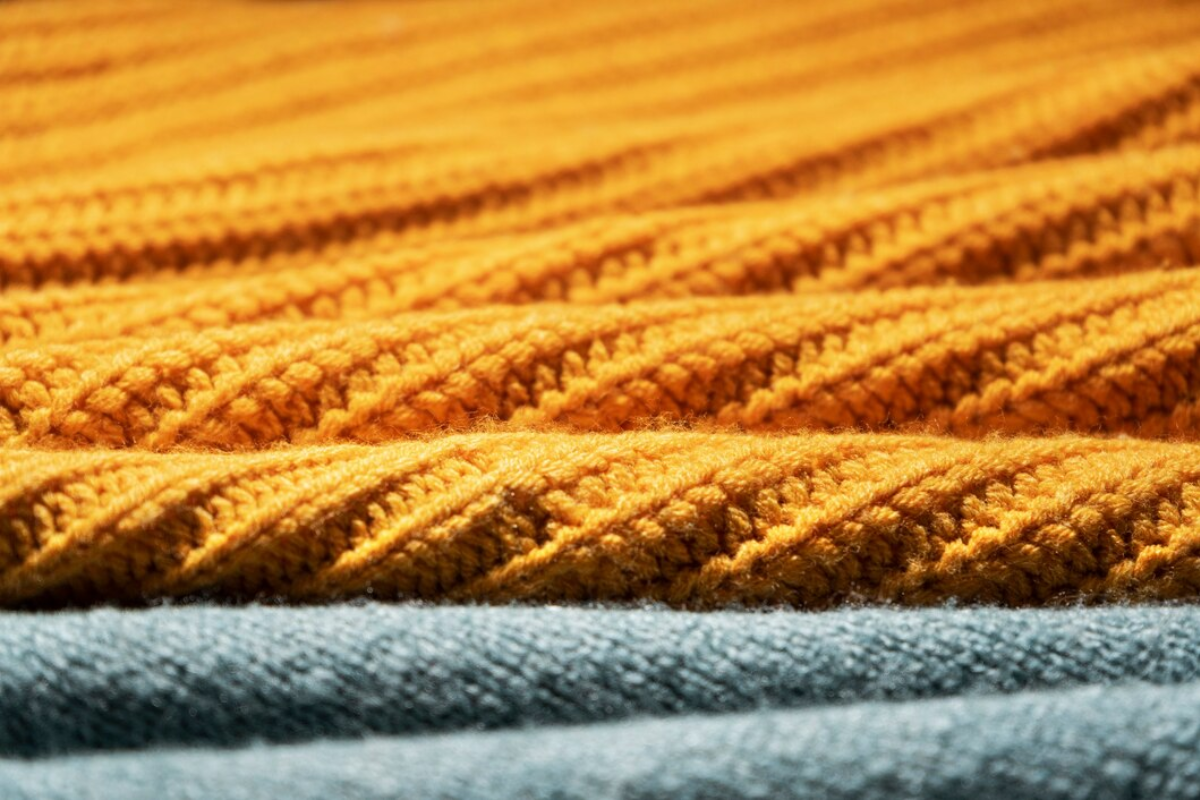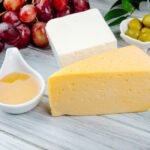Chenille is one of those fabrics you’ve probably seen, touched, or even used—without always knowing what it’s called. Known for its velvety softness and slightly fuzzy surface, chenille is popular in both home décor and fashion. Whether you’re shopping for a cozy throw blanket, updating your furniture, or browsing soft sweaters, chenille often stands out for its luxurious feel and visual warmth.
In this guide, we’ll walk you through everything about chenille—from how it’s made to how to care for it. If you’ve ever wondered why this fabric is so popular, or how it compares to similar materials, you’re in the right place.
What Is Chenille?
Chenille is a soft, textured fabric known for its fuzzy, caterpillar-like appearance. The word “chenille” actually comes from the French word for caterpillar—and once you see the fabric up close, the name makes perfect sense. It has a distinct pile that gives it a plush, warm feel, making it ideal for cozy and decorative applications.
The term “chenille” has French roots and was first used in the 18th century to describe the texture of yarn that resembled the body of a caterpillar. Over time, it evolved into a full-blown textile category, becoming popular across Europe and eventually in North America. Originally crafted by weaving fuzzy yarns through a base fabric, chenille gained popularity for its softness, warmth, and rich texture.
What sets chenille apart is its pile—the tiny tufts of yarn that stick out from the base. These fibers are cut to a uniform length, giving chenille its soft surface and signature look. It reflects light in a subtle, shimmering way, often making the fabric appear slightly iridescent. It’s soft to the touch, offers decent durability, and works well for both aesthetics and comfort.
How Chenille Is Made?
To really understand why chenille feels so luxurious, it helps to know how it’s made. Chenille production is both a science and a craft.
Chenille starts with yarn—often made by twisting short lengths of fiber between two core threads. These short fibers, called the “pile,” stand at right angles to the yarn’s core. When woven into fabric, the result is a raised, fuzzy surface that’s soft and tactile. This unique construction also gives chenille its light-catching properties, making it look different depending on the angle you view it from.
Chenille can be made from a variety of fibers, both natural and synthetic. Cotton is one of the most traditional choices, offering softness and breathability. Polyester, rayon, and acrylic are also commonly used, often blended to improve durability, color retention, and stretch. The choice of fiber affects the final feel, appearance, and use of the fabric.
Types of Chenille Fabric
Chenille isn’t one-size-fits-all. Depending on the material used and the way it’s woven, there are different types with unique textures and qualities.
Cotton Chenille
Cotton chenille is natural, breathable, and known for its soft, comforting texture. It’s often used in bedspreads, bathrobes, and baby blankets. Because it’s a natural fiber, cotton chenille is gentle on the skin and highly absorbent, but it may require careful washing to avoid shrinkage or wear.
Synthetic Chenille
Made from fibers like polyester, nylon, or acrylic, synthetic chenille tends to be more durable and resistant to fading or stretching. It’s often used in upholstery, decorative pillows, and outerwear. This type of chenille is typically easier to care for, though it might not feel as breathable as natural varieties.
Blended Varieties
Blended chenille combines natural and synthetic fibers to create a fabric that offers the best of both worlds—softness, durability, and easy care. These blends are common in modern manufacturing and widely used in both fashion and home textiles.
Popular Uses for Chenille
Chenille is incredibly versatile. Its unique feel and appearance make it suitable for a wide range of uses.
Home Décor: Upholstery, Throws, and Curtains
In home décor, chenille is a favorite for adding texture and warmth. Upholstered furniture made with chenille looks luxurious and feels comfortable. Throw blankets, bedspreads, and curtains made from chenille can add depth and coziness to any space. The fabric’s slight sheen also adds a sophisticated touch to interiors.
Clothing and Fashion
Chenille has made a strong comeback in fashion, especially for fall and winter wear. Chenille sweaters, scarves, and hats are popular for their plush feel and stylish appearance. The fabric drapes well and is often used in relaxed, casual designs that emphasize comfort.
Craft and DIY Projects
Crafters love chenille for its tactile qualities and rich appearance. It’s often used in quilting, embroidery, and DIY home accessories. Chenille yarn, in particular, is popular for knitting and crocheting cozy blankets and garments.
Chenille vs. Other Fabrics
While chenille stands out, it’s often compared to similar soft fabrics. Let’s see how it measures up.
| Feature | Chenille | Velvet | Fleece | Terry Cloth |
| Texture | Soft, fuzzy | Smooth, plush | Soft, fleecy | Loop-pile, rougher |
| Appearance | Matte to slight sheen | Glossy | Matte | Dull |
| Common Use | Décor, fashion | Luxury apparel, upholstery | Casual wear, blankets | Towels, robes |
| Breathability | Moderate | Low | High | High |
| Durability | Medium | High | Medium | High |
| Maintenance | Moderate care | High care | Easy | Easy |
How to Care for Chenille?
Caring for chenille properly can extend its lifespan and keep it looking great. Different types may require different care routines, so it’s always smart to check labels.
Washing and Drying Tips
Chenille is usually best washed on a gentle cycle in cold water. Hand washing is often recommended for delicate or 100% cotton items. To preserve the texture, avoid using high heat in the dryer. Instead, air drying or tumble drying on low is preferred.
Preventing Damage and Wear
Avoid over-washing chenille, as repeated agitation can cause the fibers to fray or mat. If using chenille for upholstery, regular vacuuming with a brush attachment can help prevent dust buildup and maintain its texture. Also, rotating chenille cushions or blankets can prevent uneven wear.
Storing Chenille Items Properly
Store chenille in a cool, dry place, away from direct sunlight, which can fade the colors. Folding it gently rather than hanging can help avoid stretching, especially with clothing or knitted items.
Is Chenille Eco-Friendly?
With sustainability top of mind, many people wonder if chenille is environmentally friendly.
Environmental Impact of Chenille Fabrics
The impact of chenille depends largely on the materials used. Cotton chenille is biodegradable but water-intensive to produce. Synthetic chenille made from polyester or acrylic has a longer life but may shed microplastics into the environment. Like most fabrics, chenille’s sustainability varies based on production practices.
Sustainable Options and Alternatives
Some brands now offer eco-friendly chenille made from recycled fibers or sustainably sourced cotton. Blends with bamboo or Tencel are emerging as greener alternatives. When shopping, look for certifications like OEKO-TEX or GOTS to ensure the fabric meets certain environmental and safety standards.
Conclusion
Chenille is a unique fabric that blends comfort, style, and warmth. Its soft, fuzzy texture has made it a favorite in homes, wardrobes, and craft rooms around the world. While it may require a bit more care than some other fabrics, the payoff is well worth it. Whether you’re selecting upholstery for your living room, picking out a new sweater, or starting a creative project, chenille offers both beauty and functionality. With the right knowledge, you can enjoy this timeless fabric in many forms—while keeping it in great shape for years to come.
FAQs
1. What makes chenille fabric so soft?
Chenille gets its softness from the way it’s made—short yarn fibers are wrapped between two core threads, then cut to create a fuzzy, plush surface.
2. Can your machine wash chenille at home?
Yes, but gently. Use cold water and a delicate cycle, and avoid high heat when drying to preserve the texture.
3. Is chenille good for people with allergies?
It depends on the material. Natural cotton chenille is generally more allergy-friendly, while synthetic types may trap more dust or cause irritation for sensitive users.
4. What’s the best use for chenille in home décor?
Chenille is great for throw blankets, cushions, and upholstered furniture. It adds softness and visual interest, especially in cozy or relaxed spaces.
My name is Mustafa, and I have been blogging for over 5 years. I am passionate about sharing complete, accurate, and helpful information with my readers. Along with managing content on The Matcha Read, I also contribute blog posts to premium websites. My goal is to provide valuable insights in a clear and easy-to-understand way, so every reader walks away with useful knowledge.










